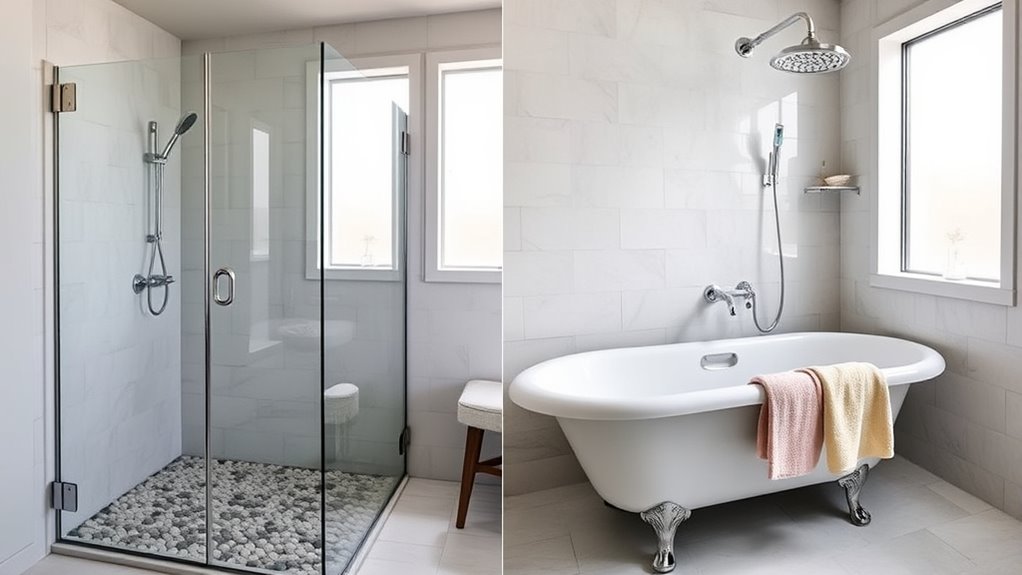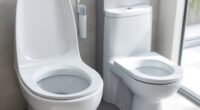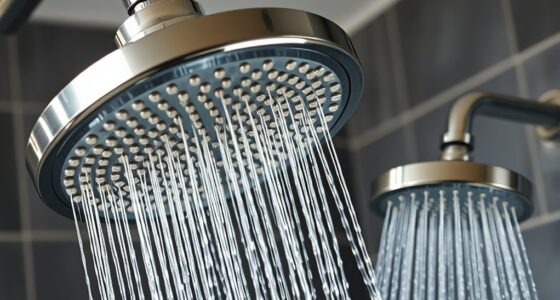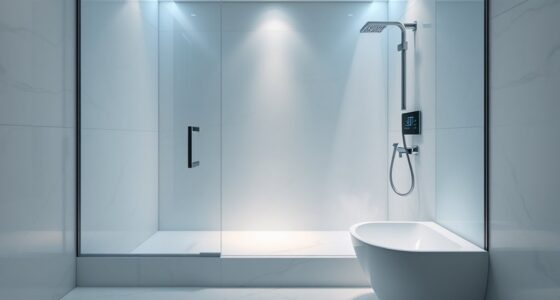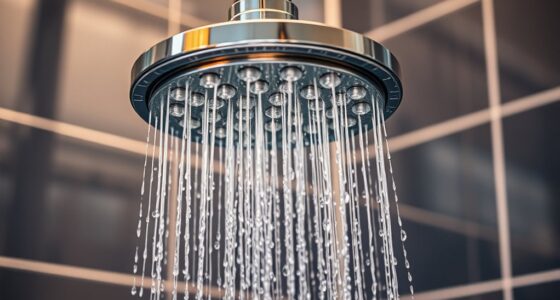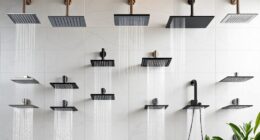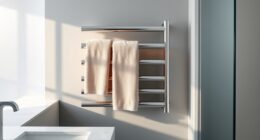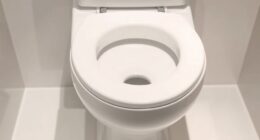Choosing between a walk-in shower and a tub-shower combo depends on your needs. Walk-in showers offer easy access, space-saving design, and lower maintenance, making them great for safety and modern style. Tub-shower combos provide versatility for baths and relaxation but take up more space and may involve higher costs. Considering your lifestyle, safety concerns, and bathroom size will guide your decision. To explore the advantages and drawbacks further, and find what fits your home best, keep exploring.
Key Takeaways
- Walk-in showers offer better accessibility and safety features, ideal for mobility challenges and fall prevention.
- Tub-shower combos provide versatility for bathing and soaking, suitable for families and relaxation needs.
- Walk-in showers typically require higher upfront costs due to waterproofing and glass enclosures.
- Tub-shower combos generally use more water and may have higher maintenance costs over time.
- Choice depends on space, lifestyle, safety considerations, and aesthetic preferences.
Accessibility and Ease of Use
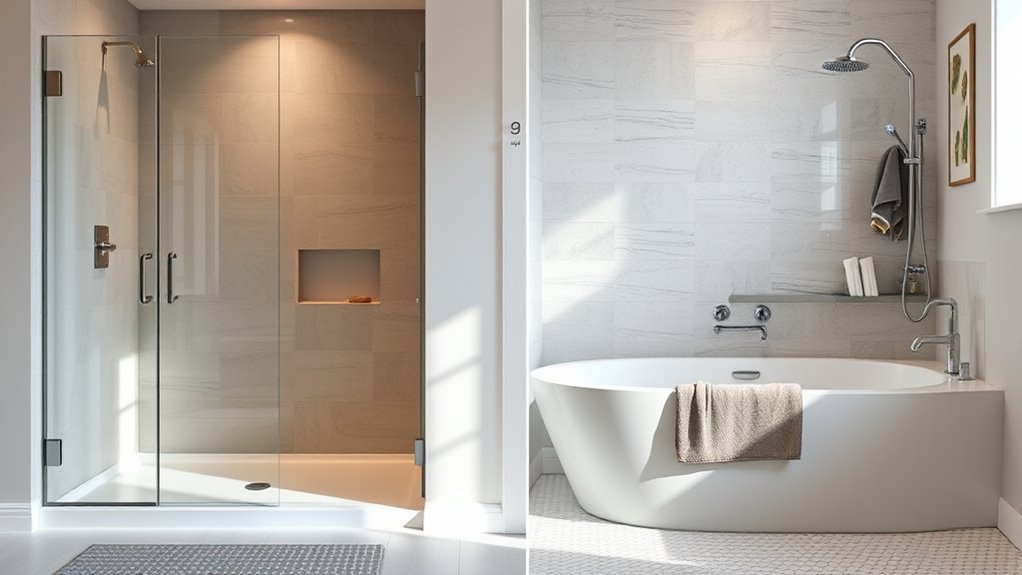
A walk-in shower often provides better accessibility and ease of use compared to a tub-shower combo, especially for those with mobility challenges. With no tub lip to step over, you can enter and exit easily, reducing the risk of slips. Custom tile options allow you to create a slip-resistant surface, enhancing safety further. Good shower lighting is essential for visibility, making it safer to use daily. You can incorporate bright, well-placed fixtures that eliminate shadows and improve clarity. The open design also simplifies cleaning and maintenance, saving you time and effort. Overall, a walk-in shower offers a more user-friendly experience, especially when tailored with features like custom tile and proper lighting, making daily routines safer and more convenient.
Space and Layout Considerations

Choosing between a walk-in shower and a tub-shower combo often depends on your available space and how you want to use the bathroom. If you have limited room, a walk-in shower offers a compact design that maximizes spatial efficiency, making your bathroom feel larger. It fits easily into tight corners and creates an open, airy feel. It also allows for a more customizable design, such as incorporating natural materials to enhance the aesthetic. On the other hand, a tub-shower combo requires more space but provides versatility, especially in shared bathrooms. Consider your layout carefully: a walk-in shower is ideal for small bathrooms, while a tub-shower combo works well if you need a bathing option without sacrificing too much space. Additionally, understanding signs of spoilage in bathroom fixtures can help you maintain a hygienic environment over time. Being aware of essential oils for bathroom health can also contribute to a cleaner and more inviting space. Proper ventilation is also crucial to prevent moisture buildup and mold growth in either setup.
Aesthetic Appeal and Style Options
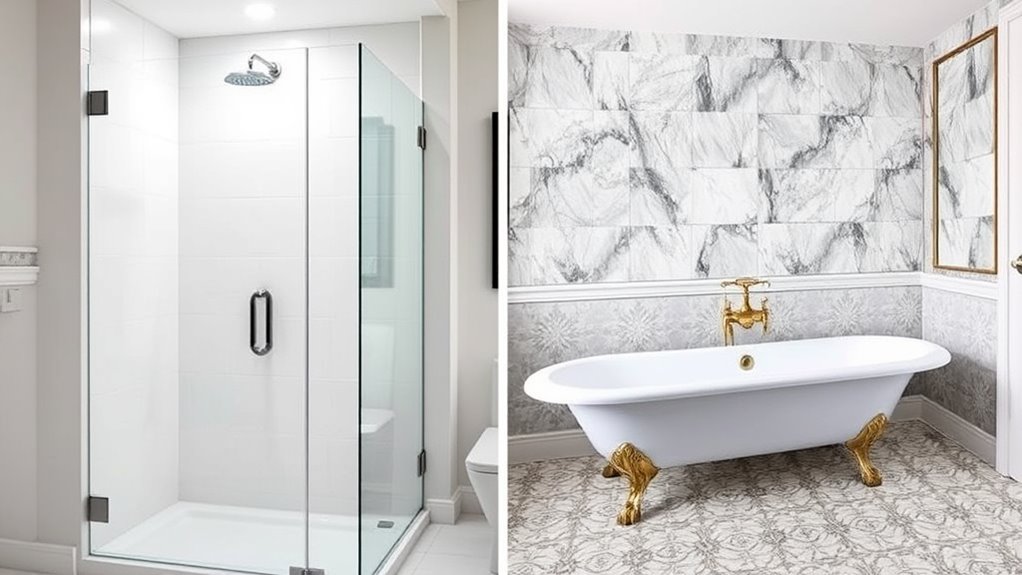
Ever wondered how your bathroom’s style can influence your choice between a walk-in shower and a tub-shower combo? Your aesthetic plays a key role in making that decision. With a tub-shower combo, you can select from various bathtub materials like porcelain, acrylic, or stone, each offering a different look and feel. These choices can add a luxurious or modern touch, depending on your style. For walk-in showers, sleek glass enclosures and minimalist tiles create a clean, contemporary appearance. Shower curtain options also matter—fabric curtains add charm and versatility, while clear or textured glass enhances openness and elegance. Ultimately, your style preferences, whether modern, traditional, or eclectic, will guide you towards a design that complements your bathroom’s overall aesthetic.
Cleaning and Maintenance Requirements
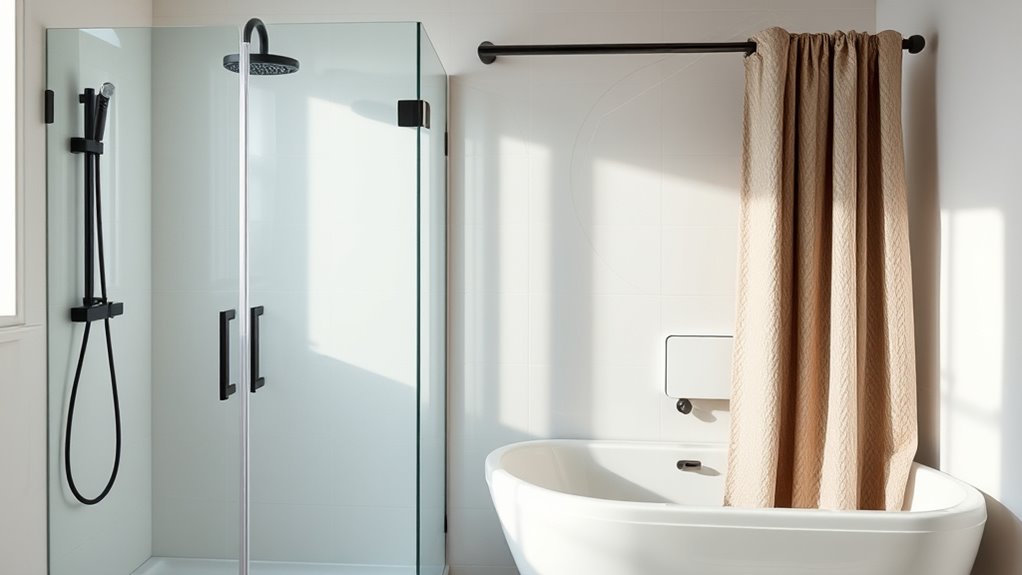
Cleaning and maintaining your bathroom fixtures can considerably impact their appearance and longevity, so understanding the requirements of each option is essential. Walk-in showers typically require regular cleaning routines to prevent soap scum and mold buildup. Tub-shower combos may need more attention around the tub edges and grout lines. Proper upkeep also involves monitoring preventing mold growth, which is a common concern in damp bathroom environments. Here are some key points to consider:
Regular cleaning preserves bathroom fixtures and prevents costly repairs over time.
- Regularly wipe down surfaces to reduce buildup.
- Use non-abrasive cleaners to protect finishes.
- Check seals and grout for mold or damage.
- Be aware that maintenance costs can increase with neglected upkeep. Additionally, choosing appropriate cleaning products can help extend the life of your fixtures and reduce the effort needed for maintenance. Incorporating regular inspections can further help identify issues early before they become costly repairs.
Both options demand consistent cleaning routines, but walk-in showers often have lower maintenance costs if kept clean. Proper upkeep helps prevent costly repairs and keeps your bathroom looking new longer.
Cost of Installation and Upkeep
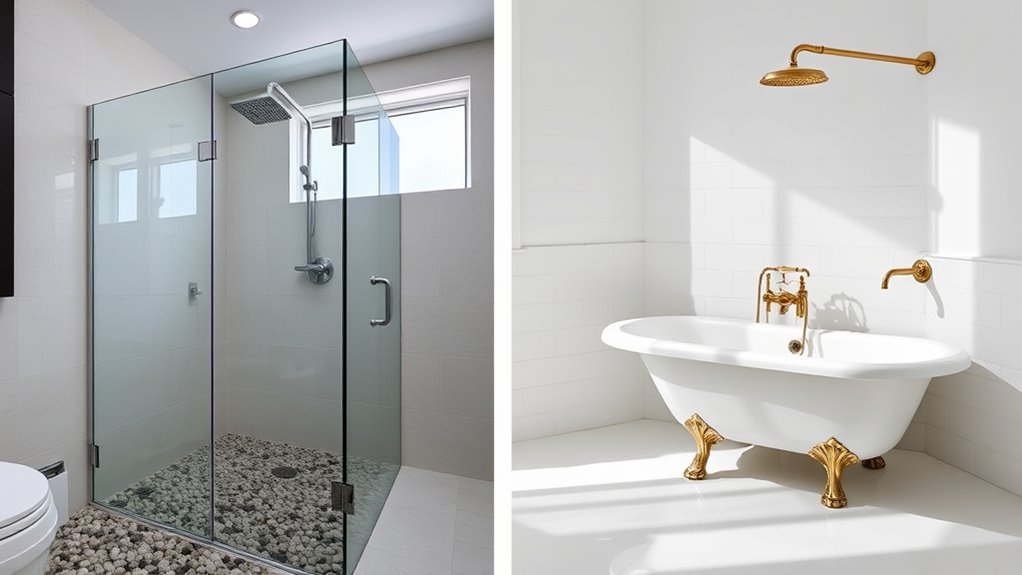
The initial costs of installing a walk-in shower generally tend to be higher than those for a tub-shower combo, mainly due to the need for custom waterproofing, glass enclosures, and sometimes specialized plumbing. You may also spend more on premium lighting options to enhance the space’s ambiance and functionality. Additionally, installing effective ventilation systems is essential to prevent mold and moisture buildup, which can add to your upfront expenses. Proper exhaust ventilation is crucial for maintaining a healthy bathroom environment and reducing long-term upkeep costs. Upkeep costs for a walk-in shower can be moderate, mainly involving cleaning glass and maintaining the waterproofing. Regular inspection and maintenance can help identify potential issues early and prevent costly repairs, especially in areas prone to moisture damage. In some cases, choosing durable, high-quality materials for the shower enclosure can reduce long-term maintenance needs.
Safety Features and Risk Factors
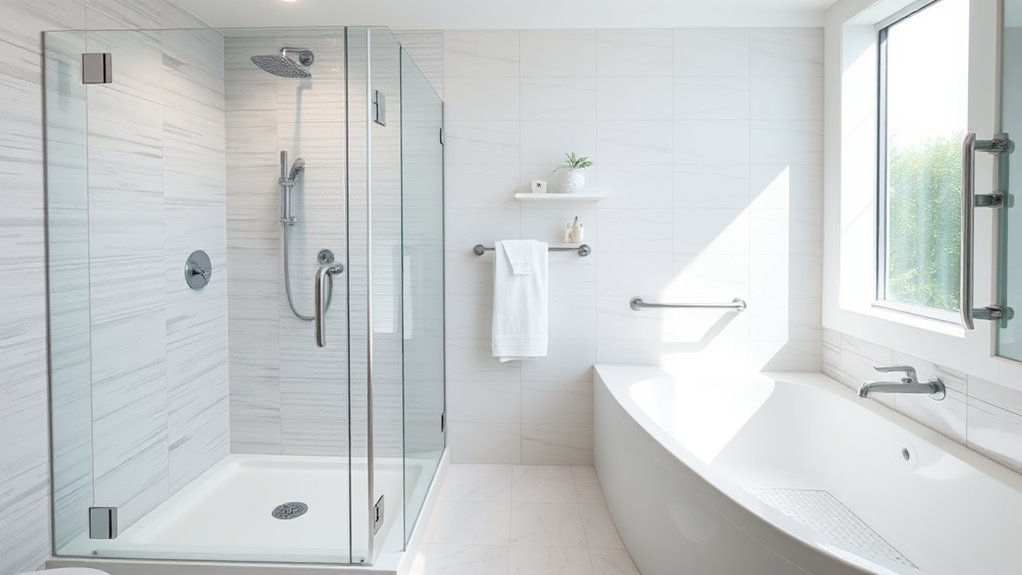
Safety features like slip-resistant surfaces and accessibility options can help prevent accidents in your bathroom. However, you should also be aware of fall risk factors that may increase your chances of injury. Considering these points helps you choose the safest option for your needs. Incorporating local tips and understanding city dynamics can further enhance your safety and comfort in your new space. Additionally, being aware of fatherhood lessons can foster a supportive environment that encourages safety awareness and shared responsibility. Understanding digital literacy programs can also empower seniors to use technology safely, reducing fall risks associated with unfamiliar devices or applications. Research shows that security systems can provide an added layer of safety, especially for vulnerable individuals in your household. Recognizing dream symbols related to safety and security can also help identify subconscious concerns about household safety.
Slip-Resistant Surfaces
Slip-resistant surfaces are essential for preventing accidents in the shower, especially since wet surfaces increase the risk of slips and falls. To stay safe, consider the following options:
- Use non-slip mats or decals that add traction without permanent changes.
- Opt for textured surfaces on the shower floor, which grip your feet better.
- Install shower bases with built-in slip-resistant finishes.
- Ensure the entire shower area is kept dry and free of soap scum, which can make surfaces slick.
- Regularly check and maintain slip-resistant features to ensure ongoing safety for enhanced safety.
- Incorporating lifestyle tips such as keeping cleaning routines consistent can maintain the effectiveness of slip-resistant features.
- Choosing high-quality slip-resistant coatings can provide additional safety benefits and durability.
Accessibility Features Included
Including accessibility features in your shower setup enhances safety by reducing the risk of falls and injuries. Installing grab bars provides sturdy support during transfers or while standing, giving you confidence and stability. Shower seat options, such as fold-down or built-in seats, allow you to sit comfortably, minimizing fatigue and imbalance. When considering safety, focus on strategic placement of grab bars and choosing appropriate shower seats to suit your needs. Keep in mind that proper installation is essential for effectiveness. Using non-slip mats can further reduce the chance of slipping in the shower area. Additionally, selecting accessible shower designs can further improve safety and ease of use for individuals with mobility challenges.
Fall Risk Factors
Understanding the fall risk factors in your shower setup is essential for maintaining safety. Poor bathtub maintenance or choosing inappropriate shower fixture options can increase your chances of slipping or losing balance. To minimize risks, consider these factors:
- Slippery surfaces: Mold, soap scum, or worn-out tiles can cause slips.
- Lack of grab bars: Without sturdy support, falling becomes more likely.
- Inadequate lighting: Poor visibility increases accident risk.
- Unstable fixtures: Loose shower fixtures or outdated bathtub maintenance can cause sudden shifts or falls.
Addressing these issues by upgrading shower fixtures, regularly maintaining the bathtub, and adding safety features can considerably reduce fall risks. Stay proactive about safety to enjoy a secure shower experience.
Water Conservation and Efficiency
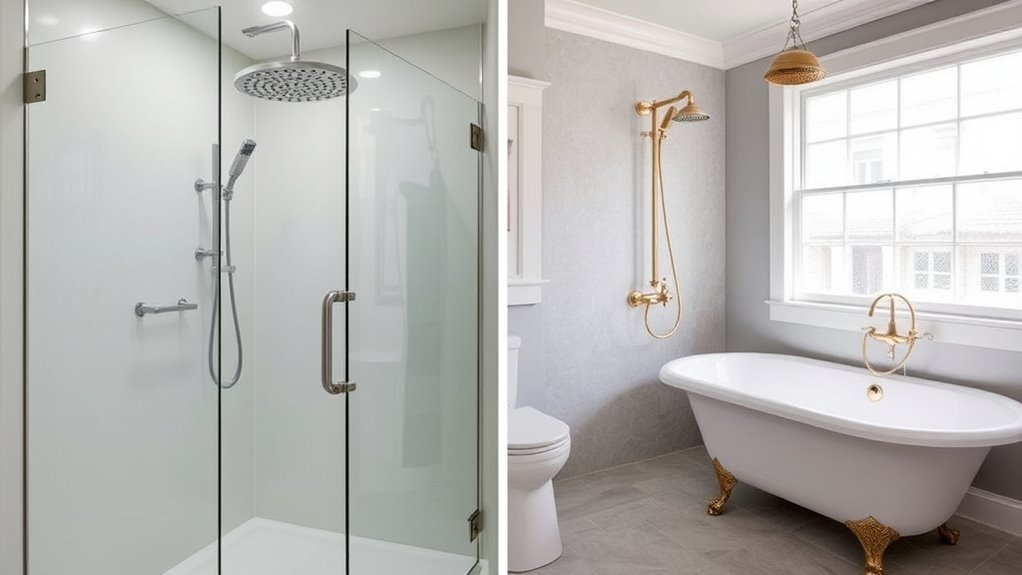
You can save water by choosing fixtures that are designed for efficiency, like low-flow showerheads. The amount of water you use depends heavily on how long you stay in the shower, so shorter showers make a big difference. Considering these factors helps you reduce water consumption without sacrificing comfort.
Water Usage Levels
When it comes to water conservation, choosing between a walk-in shower and a tub-shower combo can make a significant difference in your home’s water usage. Walk-in showers generally use less water because they typically require shorter showers and less water volume. To maximize water efficiency, you can install eco friendly fixtures that limit flow rates without sacrificing comfort. Consider these points:
- Walk-in showers often use 20-40% less water than tub-shower combos.
- Shorter showers reduce overall water consumption.
- Eco friendly fixtures help further decrease water use.
- Tubs usually hold more water, increasing consumption when used frequently.
Making an informed choice can help you conserve water and lower utility bills, aligning with your eco-friendly goals.
Eco-Friendly Fixtures
Implementing eco-friendly fixtures in your bathroom can substantially boost water conservation without sacrificing comfort. These fixtures, such as low-flow showerheads and dual-flush toilets, are designed to reduce water usage while maintaining effective performance. Eco friendly fixtures help you save money on utility bills and contribute to environmental sustainability. By choosing water-efficient options, you minimize waste without compromising your shower experience. Modern designs ensure that water conservation features blend seamlessly with your bathroom’s style. Installing these fixtures is a simple yet impactful step toward a greener lifestyle. Not only do you benefit from reduced water bills, but you also play a part in conserving this precious resource for future generations. Eco-friendly fixtures are a smart, practical upgrade for any bathroom.
Shower Duration Impact
Longer shower durations directly lead to increased water consumption, which can undermine efforts to conserve water and improve efficiency. Your shower duration and bathing habits directly impact your water footprint. To optimize efficiency, consider these points:
- Keep showers brief—aim for 5 minutes or less.
- Use water-saving showerheads to reduce flow rate.
- Develop mindful bathing habits to avoid unnecessary prolonging.
- Switch to a walk-in shower if you tend to linger, encouraging quicker showers.
Suitability for Different Household Needs
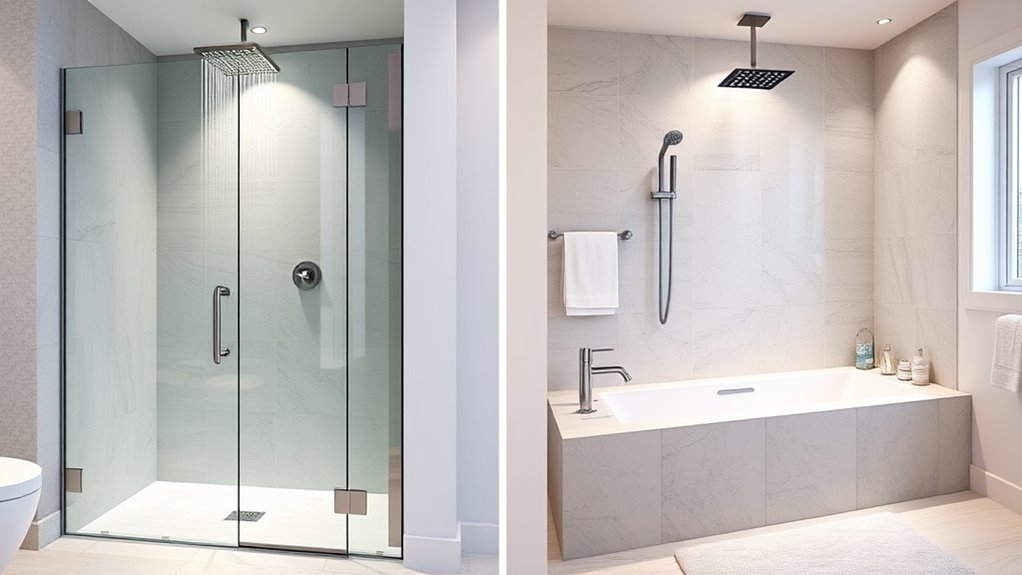
Choosing between a walk-in shower and a tub-shower combo depends heavily on your household’s specific needs. If you prefer a quick, accessible option, a walk-in shower with a freestanding design offers ease of entry and modern appeal. It’s ideal if mobility is a concern or if space is limited. On the other hand, a tub-shower combo caters to families with children or those who enjoy soaking. When installing, waterproofing techniques are vital to prevent water damage, especially in shower-only setups. Consider your household’s routines and preferences—do you need versatility or simplicity? Both options can be tailored to your needs, but understanding your daily habits ensures you select the most suitable bathing solution.
Resale Value and Home Appeal
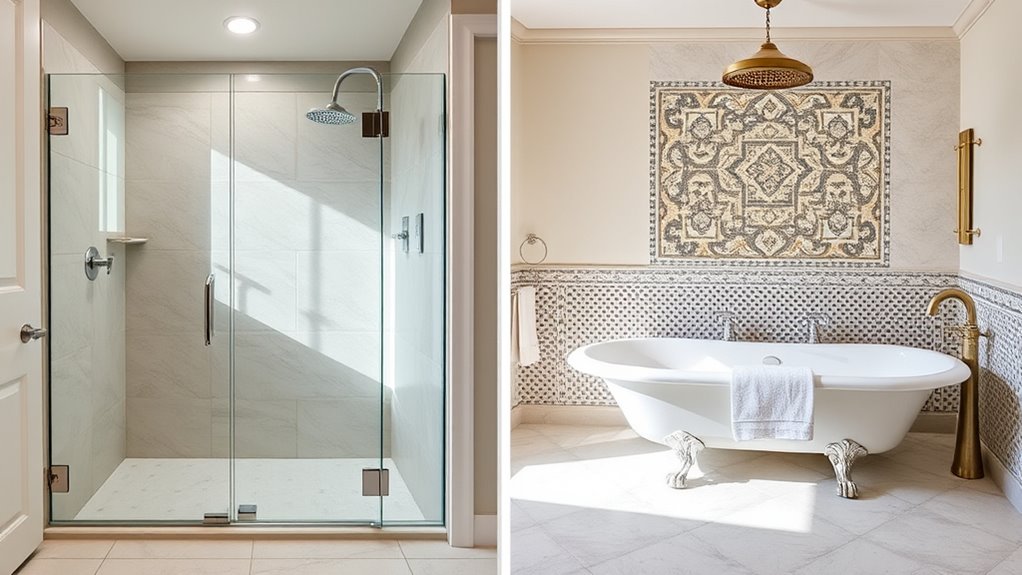
The bathroom features you select can substantially influence your home’s resale value and overall appeal. A walk-in shower with a luxury design and modern aesthetic often attracts buyers seeking contemporary, stylish spaces. It can make your bathroom look more spacious and updated, boosting curb appeal. Conversely, a tub-shower combo appeals to families or buyers valuing practicality and versatility. To maximize resale potential, consider these points:
- Modern aesthetic fixtures enhance visual appeal.
- Luxury design elements elevate perceived value.
- Spacious walk-in showers attract trendy buyers.
- Functional tub-shower combos appeal to a broader audience.
Ultimately, the choice influences your home’s marketability, with sleek, modern features increasing desirability and resale value.
Personal Lifestyle and Usage Preferences

Your daily routines and mobility needs play a big role in choosing the right setup. If space is tight or accessibility is a priority, a walk-in shower might suit you better. Consider how often you use the bath and your age or mobility when making your decision.
Space and Accessibility Needs
When considering space and accessibility needs, it’s important to think about how each option fits your daily routines and physical requirements. Your choice impacts design flexibility and installation complexity.
Here are four key points:
- Space Efficiency: Walk-in showers typically require less space, ideal for smaller bathrooms.
- Accessibility: Walk-ins are easier to access, especially for mobility issues, enhancing safety.
- Design Flexibility: Walk-ins offer more options for customizing size and style, fitting varied bathroom layouts.
- Installation Complexity: Tub-shower combos may be simpler to install in existing setups, while walk-ins might need more planning and adjustments.
Carefully evaluate your space and needs to choose the option that best supports your daily accessibility and design preferences.
Frequency of Use Preferences
Considering how often you plan to use your shower can considerably influence your choice between a walk-in and a tub-shower combo. If you prioritize luxury bathing and enjoy relaxing long showers, a walk-in shower offers a sleek, open design that enhances the experience. It provides greater design flexibility, allowing you to customize features like rainfall heads or seating. Conversely, if you prefer combining bathing and showering in one space, a tub-shower combo might suit your needs, especially if you take baths frequently or have a household with multiple users. Your personal lifestyle, whether you value quick, efficient showers or extended, indulgent baths, should guide your decision. Ultimately, choosing based on your frequency of use helps ensure your bathroom fits your routines and preferences perfectly.
Age and Mobility Considerations
As you evaluate your bathroom needs, age and mobility play crucial roles in choosing between a walk-in shower and a tub-shower combo. Consider how accessible you need your bathroom to be. For example:
- Grab bar options are essential for added safety, especially if balance is a concern.
- Walk-in showers with low thresholds make entering easier and reduce fall risks.
- Faucet types, such as lever handles, are more user-friendly for limited dexterity.
- If you prefer soaking, a tub-shower combo might be better, but ensure it has sturdy grab bars and non-slip surfaces.
Your personal mobility influences these choices, and prioritizing safety features helps maintain independence. Think about future needs, and select fixtures that support comfort and safety now and later.
Frequently Asked Questions
Which Option Is Best for Elderly or Disabled Homeowners?
You want to prioritize elderly accessibility and disabled safety when choosing a bathroom setup. A walk-in shower is typically best, as it minimizes the risk of slips and falls with no tub to step over. It offers easier entry and exit, making it safer for elderly or disabled homeowners. Plus, you can add grab bars and seating for extra support, ensuring a more accessible and secure bathing environment.
How Do Walk-In Showers Impact Bathroom Resale Value?
Think of your bathroom as a jewel in your home’s crown. Installing a walk-in shower can boost your resale value, making your bathroom shine brighter and more appealing to buyers. Its sleek, modern look enhances bathroom appeal and suggests a sense of luxury. This upgrade can attract new homeowners and potentially increase your home’s overall worth, turning a simple renovation into a valuable investment for your property’s future.
Are There Any Specific Plumbing Requirements for Each Option?
When considering plumbing requirements, you’ll find that walk-in showers typically have simpler plumbing, leading to lower installation costs and less plumbing complexity. They often need just a few additional fixtures and straightforward drainage. Conversely, tub-shower combos involve more complex plumbing, including extra water lines and drain setups, which can increase installation costs. Be sure to consult a professional to assess your space and guarantee proper plumbing for your chosen option.
Can Walk-In Showers Be Customized for Unique Bathroom Layouts?
Yes, you can customize walk-in showers to fit unique bathroom layouts. With various customization options, you can choose different sizes, shapes, and materials to match your style. Design flexibility allows you to add features like benches, niches, or multiple shower heads. This adaptability guarantees your walk-in shower complements your space perfectly, making it both functional and aesthetically pleasing, regardless of your bathroom’s unique dimensions or design preferences.
What Are the Long-Term Durability Differences Between Tubs and Showers?
When considering durability, you might worry about wear and tear over time. Tubs often use acrylic or cast iron, offering excellent material longevity and corrosion resistance, but they can chip or crack if not maintained. Showers, especially those with tile or acrylic enclosures, generally have good resistance as well. Ultimately, your choice depends on how well you care for the materials, but both can last with proper upkeep.
Conclusion
Choosing between a walk-in shower and a tub-shower combo ultimately depends on your lifestyle and priorities. While a walk-in offers sleek accessibility and easy maintenance, it may lack the versatility of a tub-shower combo for families or relaxation. Conversely, the combo provides comfort and flexibility, but might take up more space and need more upkeep. Weighing these contrasts helps you decide which option aligns best with your needs, lifestyle, and home’s future value.
